After a strong start with the 1986 Legend--the first premium-brand sedan from Japan, with a leading-edge engine and chassis--Acura's midsize sedans have had a difficult time finding their place in the world. Let's review:
1991 Legend II -- larger, sophisticated styling enabled by longitudinal FWD powertrain; eclipsed by game-changing 1990 Lexus LS
1992 Vigor -- JDM Accord with a longitudinal five, rear-drive proportions, and tight interior; sales far from vigorous
1996 RL I -- redesigned and renamed Legend with forgettable looks and an even more forgettable name
1996 TL I -- enlarged Vigor, doubled sales (name change helped here)
1999 TL II -- US Accord-based, transverse engine, sporty Type S, sales 3X
2004 TL III -- sophisticated sporty styling, right-sized, fun-to-drive; sales peak
2004 TSX -- rebadged European Accord, reviewers praised handling, sold OK
2005 RL II -- revert to transverse engine; still forgettable aside from the intro of SH-AWD
2009 TL IV -- bigger (ISO Lexus ES buyers), uglier (ISO a distinctive face); lost gains of TL II and III despite available SH-AWD,
2009 TSX II -- also bigger, same unloved face, less engaging; still sold OK
2014 RLX -- final 7/10 attempt at a flagship sedan; sank
2015 TLX -- with sedans in retreat, replaced both TL IV and TSX II
The first TLX couldn't decide if it wanted to be a sports sedan or a luxury sedan, and wasn't notably good at either role. It sold only about as well as the TSX alone. In my review of the 2015 TLX I wished for tauter handling, a more modern interior, and especially "more artful and distinctive styling."
To deliver all three, Acura gave the 2021 TLX its own chassis--no more Accord hand-me-ups. But it's also larger, heavier, and pricier. Has Acura rediscovered the magic formula that made the 2004 TL their biggest sedan success? Or have they repeated too many past mistakes?
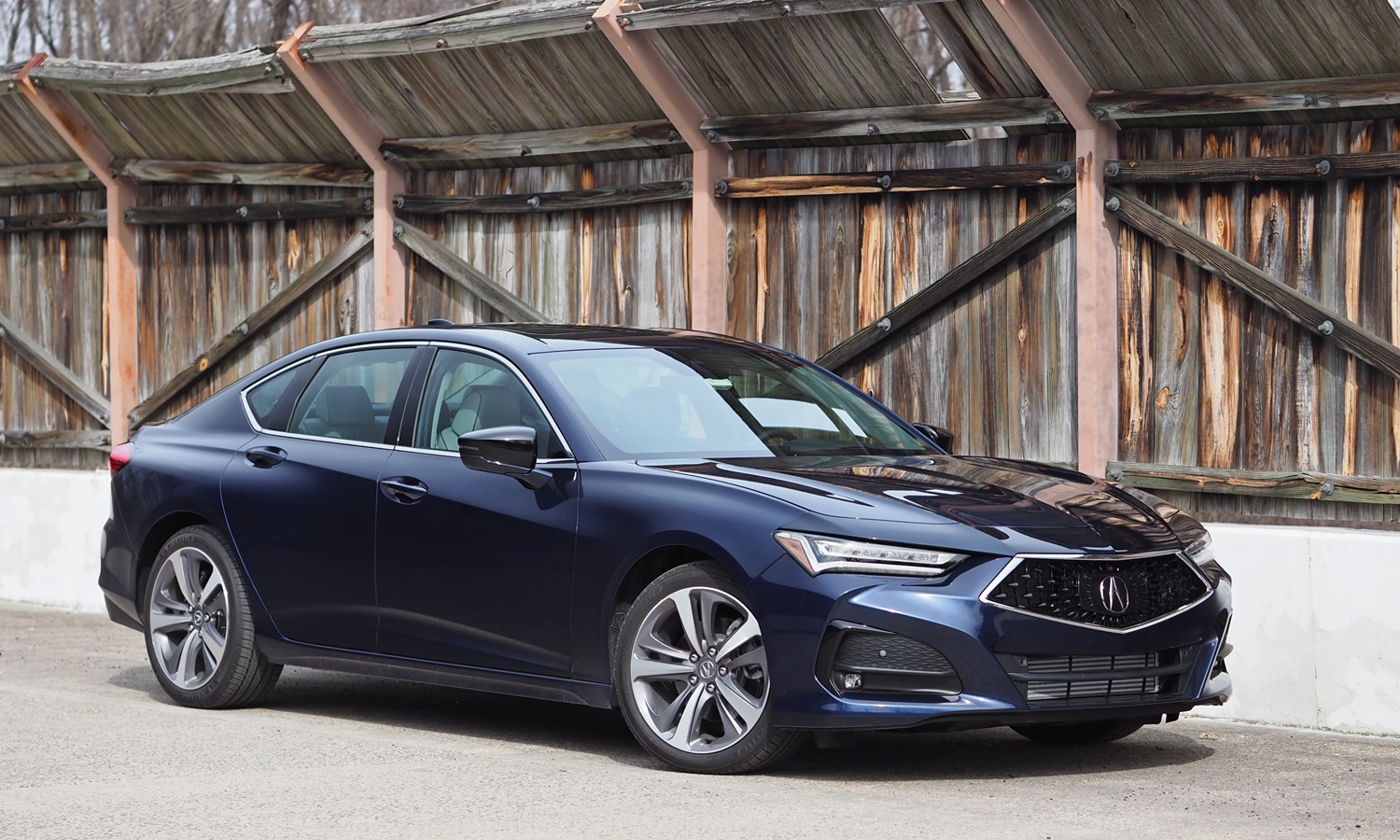
Muscular fenders, yet elegant in 2.0T Advance form with 19s. This blue one of three no-cost colors. more TLX photos
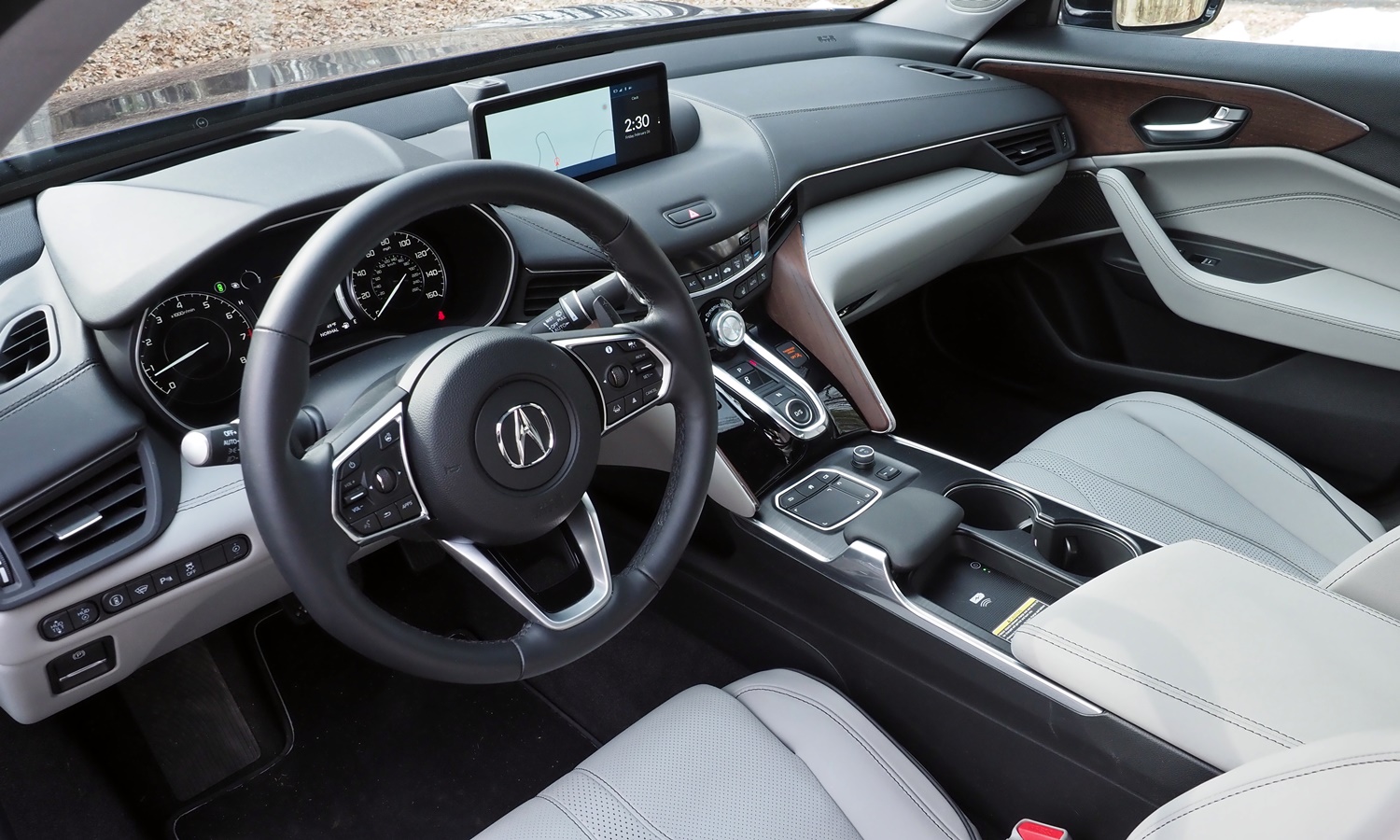
Artful interior with few straight lines. Advance replaces aluminum with natural-finished wood trim.
| |
Compared to the G70 |
| Reliability & durability |
|
When Acura launched, it promised the performance of a European car with the reliability of a Honda. They've often fulfilled this promise. But not always--the second TL was notorious for transmission failures. The first-year TLX V6 also had issues (if relatively minor ones) in this area. With the new TLX, the iffy ZF-supplied nine-speed automatic transmission has been replaced by a more solid Honda-developed ten-speed that first appeared in the 2018 Honda Odyssey.
Another potential source of concern: turbocharged engines have replaced the old TLX's naturally aspirated ones. Will the boosted engines prove as long-lived? The first turbocharged Acura, the 2007-12 RDX, was among the make's least reliable cars. But Honda has been producing turbocharged engines in volume since 2016, and (aside from some cases of disappearing coolant in CR-Vs) so far these have been reliable. While the V6 in the Type S is all-new for 2021, and thus might warrant some caution, the turbo four in other TLXs has been in production for four years. Still not sure you want a turbo? Well, if you're buying a new car in this class you don't have much of a choice: nearly all of the TLX's competitors are also turbocharged.
We should also take a step back and wonder whether the widespread belief that an Acura will require less frequent and less expensive repairs than the typical European sedan remains valid. In some well-known reliability surveys, the TLX has scored no higher and sometimes considerably lower than the Audi A4 / S4 and BMW 3 Series--which have improved in recent years.
That noted, it's important to realize that the scores from these surveys cover at most the first three years of ownership, and often much less. TrueDelta's car reliability data suggest that many German-brand cars have become reliable for the first four years of ownership, and even the first six. (It's probably a coincidence that CPO warranties last for six years.) Any sizable advantage of Asian-brand cars begins after that point, and can become quite large after their tenth birthdays. Will this be the case with the new Acura TLX? It's too soon to know for certain. But based on past history it likely will be. So the TLX retains an attraction for people who want the driving experience of a European sedan without the long-term reliability concerns of a European sedan.
The TLX doesn't have this space to itself. People can now hope for the same from two Korean competitors, the Hyundai G70 and Kia Stinger. For this reason as well as pricing, I've opted to primarily compare the new TSX to the G70 and also note how it compares to the Stinger.
I haven't indicated which car should be more reliable as the 2021 TLX is too new to really know.
| Exterior styling |
 Better
Worse
Better
Worse
|
Most often Acura's designs have been overly safe and uninspired. They made no statement. On the road they were little (if any) more visible than Hondas. The fourth-generation TL erred in the other direction, trying too hard to stand out via heavyhanded flourishes such as pointy ends and a beak-like grille. But its replacement, the first TLX, returned to bland invisibility.
The new TLX, with a sleeker, edgier, and more muscular body, makes a much stronger statement yet remains tasteful. Chevrolet tried to lend the 2013 Malibu the visual character of a Camaro. A more successful effort would have yielded a body like the new TLX's.
A key ingredient: more Camaro-like proportions. These weren't achieved easily. Acura is the Audi of Japan. Both makes rely on a high-volume sister brand. Both remain committed to front-wheel-drive architectures but face rear-drive competitors. This puts them at a disadvantage. With a conventional front-wheel-drive architecture, the front wheel must be farther behind the grille and closer to the passenger compartment. In insider jargon, front-drivers typically have more front overhang and a shorter dash-to-axle.
One solution: orient the engine longitudinally rather than transversely and use an unconventional drivetrain to connect to the front wheels. Acura did this with the 2nd Legend, the Vigor, and their immediate successors. While this yielded more aesthetically pleasing proportions, it reduced rear legroom and increased costs, hurting sales and profits. Audi has been edging in this direction in recent design generations, but not so far as to significantly harm space efficiency. The aesthetic impact has also been less dramatic, but sales have been good.
Beginning in 2014, Mazda took a different approach, retaining a transverse powertrain layout but adding a few inches between the dash and axle. The resulting cars look good but do have relatively tight rear seats. Sales have been strong for the CX-5 crossover, middling otherwise. The Mazda6 sedan won't be returning for 2022.
With the new TLX, Acura has taken the Mazda approach to the next level, adding nearly eight inches between the dash and axle compared to the previous TLX. This opens up much useless space between the four-cylinder engine and the firewall (which the V6 in the Type S only partly fills), but the car's proportions benefit dramatically.
Of course, proportions alone are not enough. Acura similarly proportioned the second Legend, but the rest of the design was too subtle to catch the eye of the general public. As noted above, the new TLX shouldn't have this problem.
I like the Genesis G70 very much. But compared to the TLX it has a more derivative shape (like Infiniti, it borrows from Jaguar) and more fake vents. The Kia Stinger poses more competition than the G70 on the exterior design front, but the TLX makes a stronger, cleaner statement.
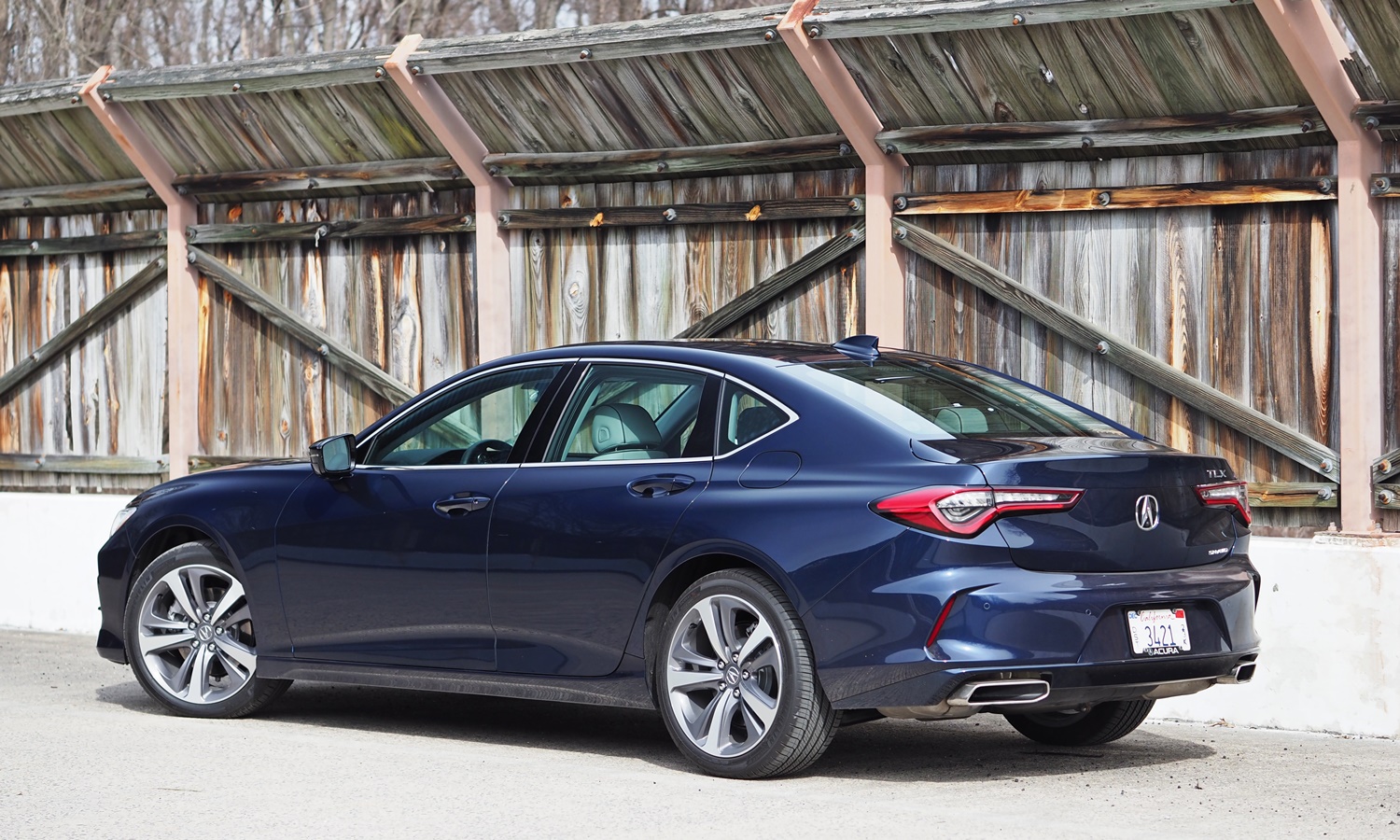
Looks high-end European from this angle. Much happening in the rear fender--bulge makes it all work.
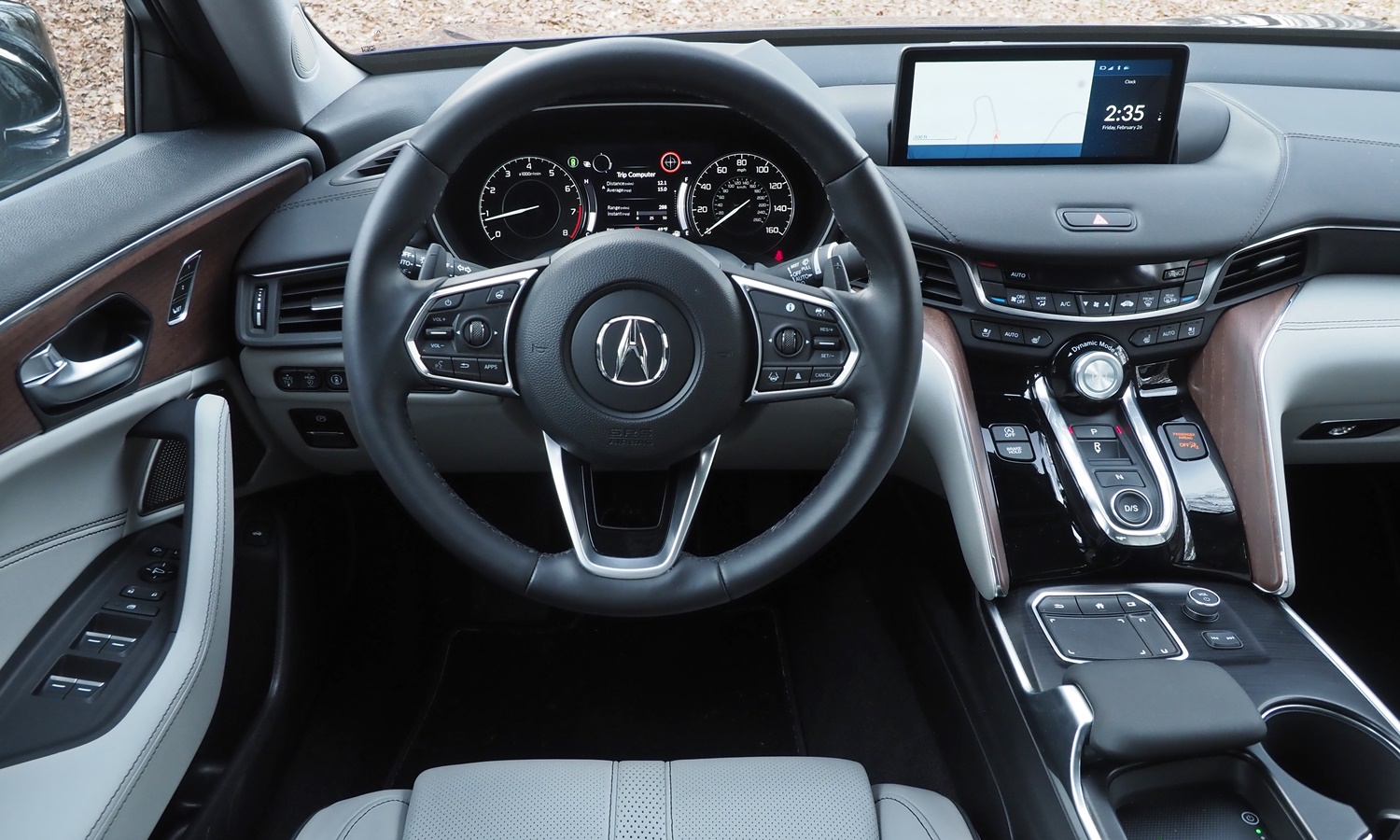
Cockpit. Transmission controls occupy much of center stack to clear space for touchpad on console.
| Interior styling |
 Better
Worse
Better
Worse
|
Unlike that of the old TLX, the cabin of the new TLX no longer seeks to coddle the traditional luxury crowd. Even more than its exterior, the new TLX's interior looks as sporty as the suits dared to make it, with dramatic forms, few straight lines, large controls, and an unusually compact center stack. Is it a bit too busy? Perhaps. But the many bits and curves cohere to form a clear, distinctive theme that's visually interesting and far from boring. If you feel like you're sitting in a cockpit, this was purely intentional.
Materials are a clear step up from those of the previous TLX, which were a step up from those in the plasticky final TL. In the A-Spec, Advance, and Type S the instrument panel is upholstered. In the Advance, the wood is the real deal, with a natural finish like you'll find in the finest competitors (and not the shiny stuff I found offputting in the previous TLX).
Overall, the materials in the Genesis G70 are slightly better. In design, the G70's interior is cleaner but less distinctive and less interesting. Jaguar appears to have been a strong influence here as well. (If the interior of the new-for-2022 GV70 crossover is any indication, they'll be more adventurous next time.) The Kia Stinger has distinctive, somewhat retro interior styling, but even after an upgrade for 2022 it looks and feels cheaper inside than the Acura or the Genesis.
But does the TLX's interior design function well? That falls into other categories, which we'll get to.
| Handling |
 Better
Worse
Better
Worse
|
Like Audi's, Acura's commitment to front-wheel-drive (FWD) yields advantages and disadvantages. Compared to rear-wheel-drive cars, FWD cars are inherently less tricky to drive on slick roads. Many potential buyers, if they had to choose between FWD and RWD, would go with FWD (and thus the TLX rather than competitors) for this reason. But FWD also yields a more nose-heavy weight distribution, and with it more understeer (resistance to holding a tight line through a curve). FWD also makes for less dynamic handling, as the attitude of the chassis can't be adjusted with the throttle to nearly the same extent when the same wheels steer and transfer power. Lastly, FWD can't put nearly as much power to the ground without undesirable drama.
Like Audi, Acura has addressed the needs of enthusiasts with all-wheel-drive (AWD), which eliminates FWD's traction issues and torque steer. Then, to counteract understeer, Acura went a step further and designed a "super-handling" SH-AWD system that can shunt up to 70 percent of torque to the outside rear wheel in curves. In the TLX with SH-AWD (standard on the Type S, optional on the others) you can rotate the car with the throttle somewhat like you can a RWD car. (Audi offers a torque-vectoring rear differential, but only in a $2,500 package on the high-performance S4.)
But Genesis and Kia also offer AWD, and I've never driven an AWD car that feels as much like a rear-driver as the G70 3.3T does. It provides oversteer-on-demand with a confidence-inspiring progressiveness.
Beyond their drivetrain layouts, the TLX and G70 differ greatly in character, especially in their V6 forms. I drove these back-to-back at a media association event. The TLX Type S is a more overtly sporty car, with Alfa-quick steering and Alfa-abundant engine noises (some via audio). Fun? Absolutely. The TLX's dedicated chassis, with double wishbones up front and five links in back, delivers poise. It's the most entertaining and capable midsize Acura to date, a worthy successor to the TL Type S. The regular TLX (which I drove for a week) is more sedate, if admirably competent and even moderately fun on twisty roads.
But I didn't connect with the even the Type S like I did with the G70. The Genesis feels smaller and lighter--because it is--and more agile. Beyond this, it consistently reacts exactly how I expect it to, with engaging and confidence-inspiring feedback. I also recently drove the 503-horsepower BMW M4. Tremendous power, grip, and all-around competence--but I felt like I was issuing commands and it was executing them. In contrast, the G70 is a thoroughly interactive dance partner, which I find more enjoyable, even sublime.
Some people will prefer the TLX's more overt sportiness, and perhaps even its heftier feel--I myself would find it more fun in some driving--so handling is a "why to buy" despite my personal preference for the G70.
| |
Compared to the G70 |
| Rear seat room & comfort |
 Better
Worse
Better
Worse
|
It might seem unfair to compare the Acura TLX to the Genesis G70, as the latter is considerably smaller: 194.6 vs. 184.4 inches long, 75.2 vs. 72.8 inches wide, and 56.4 vs. 55.1 inches tall. The TLX is also two-to-three-hundred pounds heavier, 3,709 vs. 3,516 pounds for the 2WD fours, 4,221 vs. 3,887 pounds for the AWD V6s. In fact, compared to the second Legend--which seemed like a fairly large car in the early 1990s--the new TLX is virtually as long, four inches wider, and an inch taller. The car that was intended to replace the TSX as well as the TL has grown to the size of the final TL, which many (including me) thought too large, and weighs about 250 pounds more. Size and weight aren't good for handling agility, performance, or fuel efficiency. So, to keep match-ups fair in these and other areas, normally I compare cars that are close in size.
But, the thing is, part of the cost of the TLX's dramatically lengthened dash-to-axle is a rear seat with no more legroom than in the smaller G70. Also, despite the TLX's additional width and height, it provides only slightly more rear shoulder room and less rear headroom than the rear-drive Genesis. Adults any taller than the average man will find the TLX's rear seat a tight fit. The Kia Stinger, which is a half-foot longer than the G70 but still a few inches shorter than the TLX, provides a useful additional inch-and-a-half of legroom.
Front-wheel-drive transverse powertrains were originally adopted because, when turned sideways, the engine and transmission take up much less of a car's length. By taking a conventional front-wheel-drive powertrain and merely shifting it forward nearly eight inches, while only adding half as much to the wheelbase, Acura has sacrificed this advantage, and then some.* The no-longer-closely-related Honda Accord is 2.4 inches less lengthy but has 5.3 inches more legroom--a huge difference. Add these two number up and you get...the TLX's increased dash-to-axle. The Accord also weighs 300 pounds less. Acura's been here before--with the Vigor.
Okay, not quite. The Vigor's rear seat was so tight only children and small adults fit. The new TLX has about 3.5 more inches of legroom. This not only brings it even with the G70, but if you compare its shoulder and leg room to those of the best-selling 3rd TL you'll find they're surprsingly close. A coincidence? I doubt it.
But some people might expect more from the new TLX given its larger exterior.
* One alternative at least one manufacturer has considered: rotating a transverse powertrain 180 degrees, putting the engine behind the axle rather than ahead of it. The decreased front overhang this would enable would compensate for the increased dash-to-axle, and together they would yield even better proportions. But no one has produced a car with such a layout. The impediment for Acura or Audi: it would make AWD very difficult.
| Controls and instruments |
 Better
Worse
Better
Worse
|
I praised the sporty, cockpit appearance of the new Acura TLX's interior. Functionality is another matter.
Acura's latest stab at an infotainment interface centers on a console-mounted touchpad that, unlike others (themselves rarely easy to use), uses absolute positioning. No need to drag across the pad multiple times to get the cursor from one side of the display to the other. The top-left corner of the pad corresponds to the top-left corner of the display, the bottom-left corner corresponds to the bottom-left corner, and so forth. After some acclimatizaton I found this interface easier to use while driving than other pads or a touchscreen. Good ergonomics and a palmrest mounted just behind the pad help. But some people will find this system difficult.
The audio system has a dedicated knob and rocker switch on the center console to the right of the touchpad. These work well.
The large conventionally styled instruments look good, are highly legible, and (in their sport mode) include a boost gauge and g-meter.
Now for the things I don't like.
In a week of driving I never figured out how to reset the trip fuel economy. Perhaps I should have RTFM, but this shouldn't be so difficult.
The navigation map kept zooming out automatically even though this made it difficult to tell precisely where I needed to turn. So I'd manually zoom in, only to have it automatically zoom out again not much later.
Many manufacturers have been trying to reinvent the transmission controls. Honda and Acura's attempt--a motley crew of buttons and switches--isn't remotely as intuitive as a lever. The alleged purpose of the newfangled controls is to open up space in the center console for other things, such as the touchpad just described--but the Honda / Acura solution occupies about as much real estate as a lever would.
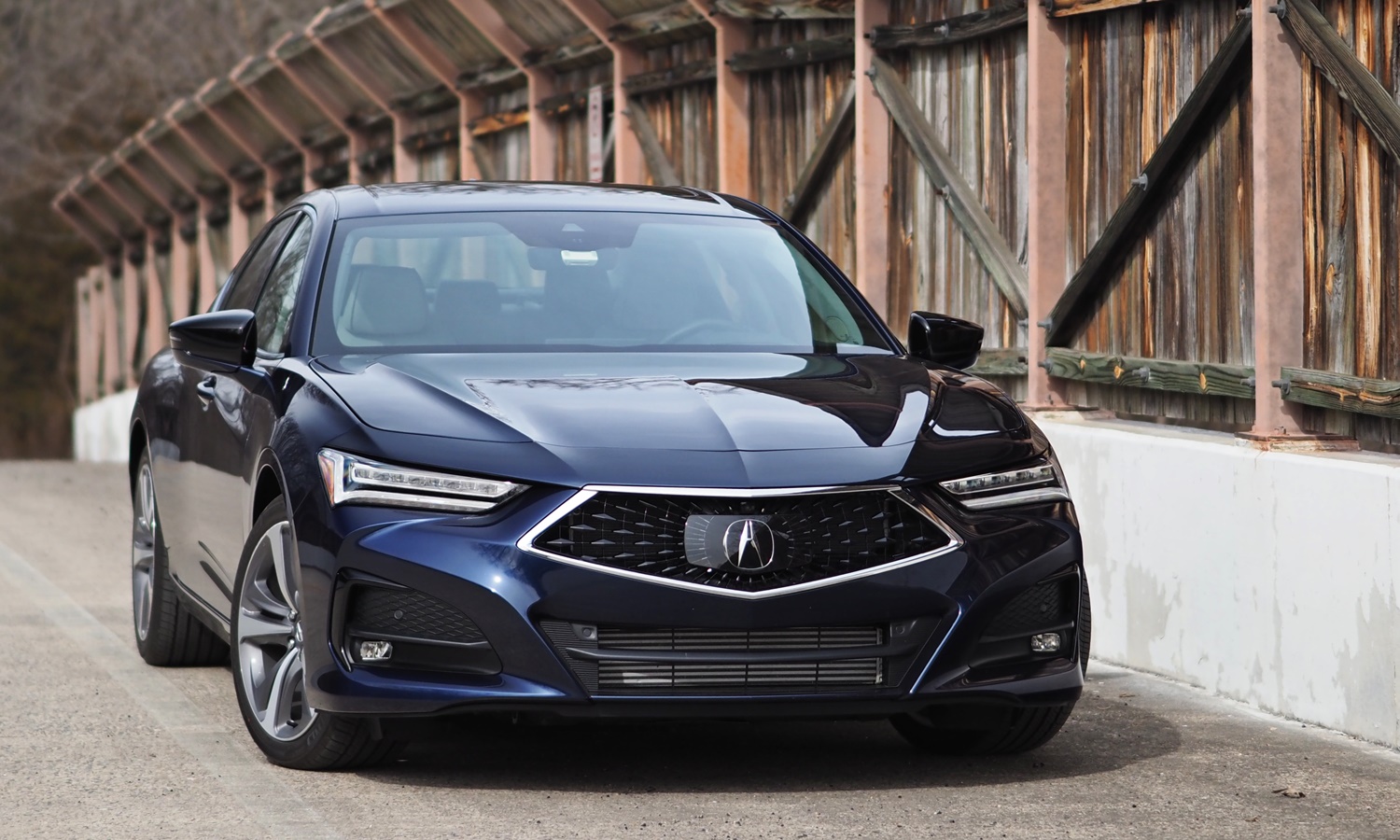
Wide, low nose. Strong horizontal emphasis from LED headlight strips, stretched pentagonal grille.
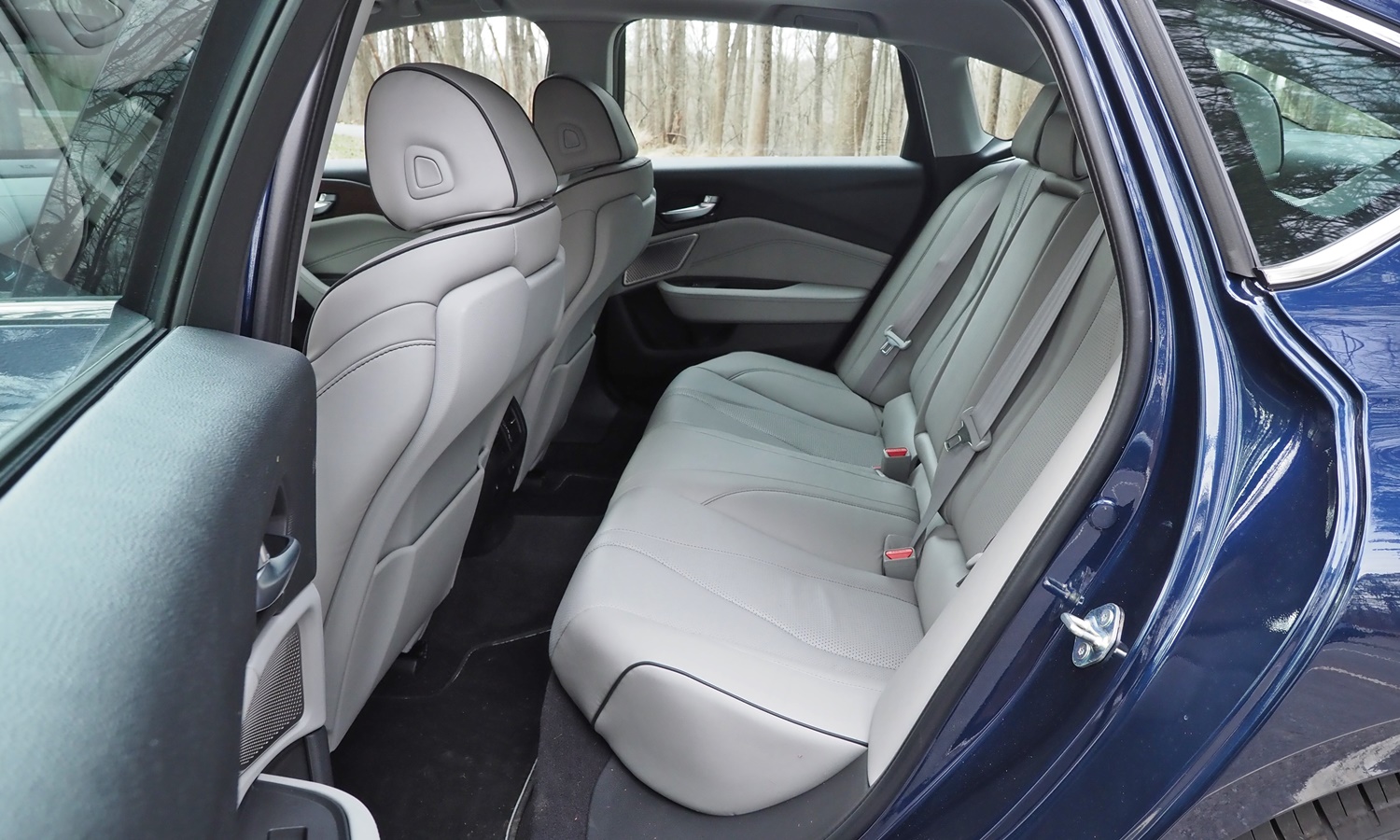
Marginal rear seat room. But the successful 3rd TL was no roomier.
| Price or payments |
 Better
Worse
Better
Worse
|
If the Genesis G70 didn't exist, you wouldn't find price among the reasons not to buy an Acura TLX. But it does, so you do.
Pulling out all stops, Honda gave the TLX its own performance-oriented chassis and Acura its own turbocharged V6 engine. Sacrificing economies of scale while upgrading interior materials and turbocharging the engines translates to higher costs--and a higher price.
How much higher? $4,500 higher. The 2020 started at $34,000, the 2021 at $38,500. The 2021 is more car in terms of performance, handling, and interior materials, but this is a big jump.
Compared to the much roomier Honda Accord 2.0T, after adjusting for feature differences the Acura TLX costs about $4,000 more.
Load up the 2021 TLX 2.0T with SH-AWD ($2,000) and the $8,800 Advance Package (which includes some features not available on the performance-oriented Type S), and you have the $49,325 sticker of the car I spent a week with. You can choose among gray, silver, and blue at no extra charge; unless you get the Type S, in which case only gray is standard. Other colors add $500. Add another $500 for the 2022.
At $50,000, you have other options. For example, you could get the Genesis G70 3.3T AWD Sport Advanced. You give up a few features compared to the TLX 2.0T Advance, but gain a few others along with a 365-horsepower V6 and a delightful chassis (for detailed price and feature comparisons, click).
Of course you don't have to load up either car, and the G70 is also offered with a 252-horsepower 2.0T engine. (Alas, the base G70 did not gain the corp's newer 300-horsepower 2.5T engine with its 2022 update.) Compare base TLX to base G70, and Genesis is $475 less. Feature differences largely cancel out. Pretty close. Unfortunately I haven't driven the four-cylinder G70, so I cannot comment on how its performance compares.
Or maybe you want a V6, adaptive dampers, an active or limited-slip rear differential, and Brembos in both cars. Compare the TLX Type S to the G70 3.3T Sport Prestige, and the latter's $53,945 bottom line is $400 lower than the Acura's despite about $2,000 in additional content. I'm sorry, Acura, you've designed and engineered a very nice car but this isn't a hard choice to make.
Possibly worth noting: the G70 is assembled in Korea, while Acura makes the TLX and its V6 engine in Ohio, and its transmission in Georgia. I say "possibly" because cheap Korean labor is a thing of the past. The average Korean auto worker now earns about $80,000.
Switch the comparison to the Kia Stinger, with more rear legroom and a versatile hatch, and the price comparisons turn out much the same. A Stinger GT2 AWD lists for $200 more than the TLX Type S but includes about $900 in additional content.
For a more favorable price comparison, there's always something European. Compared to the TLX Type S, a similarly equipped 349-horse Audi S4 lists for $8,450 more.
| |
Compared to the G70 |
| Powertrain performance |
 Better
Worse
Better
Worse
|
We've talked about the 2021 Acura TLX's weight issues a few times already. These take their toll on performance. The new TLX is quick, but lighter and/or more powerful competitors are quicker.
Despite an on-paper power advantage, the 272-horsepower TLX 2.0T doesn't feel as strong as a 255-horsepower BMW 330i or a 261-horsepower Audi A4. Especially not in typical around-town driving, where the ten-speed automatic often lugs the engine. Mat the accelerator, or manual shift the transmission to keep engine revs up, and the four feels less lethargic and sounds less pedestrian. Zero-to-60 then happens in about 6.5 seconds, similar to the BMW but a bit behind the Audi. Still, competitors tend to require the spurs less. On twisty mountain roads in the TLX 2.0T SH-AWD, I found I had to manually shift the transmission to get an appropriate gear, usually 3rd or 4th. With sufficient thrust I could use the trick AWD system to counteract the nose-heavy Acura's inherent tendency to understeer.
The 355-horsepower turbocharged 3.0-liter V6 in the TLX Type S feels both stronger and much more responsive, especially in Sport or Sport+ mode. It also makes sounds much more suitable to a sports sedan (sometimes too much or too many of these, but this can be adjusted). It will get to 60 from a dead stop in about 5.5 seconds, in the same ballpark as the Audi S4. But the 300-pound-lighter, 365-horsepower Genesis G70 will get there about a half-second sooner than the Acura.
None of the above can keep up with BMW's latest boosted six. The M340i supposedly has "only" 382 horsepower, but it pulls like it has far more. Driving the Toyota Supra and the BMW 440i with this engine, the word that came to mind to describe its power was "explosive." Sixty arrives in about 4.5. Then again, the BMW starts at $55,695 with far less standard than the TLX Type S, and comparably equipped will cost more than the Audi.
| Fuel economy |
 Better
Worse
Better
Worse
|
Have I mentioned that the new Acura TLX is a bit hefty, and that this isn't good for fuel economy?
Actually, though the TLX's EPA ratings are far from class-leading they aren't awful: 22/31 for the 2.0T FWD, 21/29 for the tested 2.0T SH-AWD, and 19/25 for the Type S.
The Genesis G70, though it's smaller and weighs less, scores a little lower: 21/31, 20/28, and 17/25 for the equivalent powertrains.
BMW leads here. The 3 Series with equivalent powertrains is rated 26/36, 25/34, and 23/32. The ultra-quick M340i with AWD scores a bit better in the EPA's tests than a TLX with a four-cylinder and FWD and far better than the Type S. The Audi A4 and S4 rate better than the Acura and Genesis, but not quite as well as the BMW.
In my week with the TLX 2.0T SH-AWD the trip computer reported about 30 mpg at 75 mph on the Interstate, close to the EPA highway rating. Steadily cruising around 60-to-65 mph it might manage 35 mpg. But around town the trip computer average fell into the high teens, 20 max, and on mountain roads it went through a gallon about every 16 miles. The implication: as long as you keep the engine off-boost and at low rpm, it's fairly efficient, but when exercised it can burn premium like an engine with twice as many cylinders (or the rotary in my RX-8).
The Acura TLX in 2.0T Advance and Type S forms has adaptive dampers. My time in the latter was relatively brief and on fairly good roads. Even in "sport" mode the ride seemed only [checks notes] "somewhat firm." I could feel bumps in the road, but the ride didn't strike me as harsh.
I had more time to try out different modes in the 2.0T Advance, and concluded that the ride felt faintly jiggly in "normal" and on most road surfaces felt better damped in "sport." In its review, Car and Driver made a similar observation, and added that the conventionally damped suspension in lesser trim levels (which I haven't driven) strikes the right balance--so there might be little benefit from the fancy adaptive units.
I did not have enough seat time in the Genesis G70 to compare its ride quality with much confidence. My impression was the G70 3.3T and TLX Type S rode about equally well, but roads in poorer condition might separate them.
Though the TLX lacks the laminated front door glass you'll find in the Genesis G70 and Kia Stinger, wind noise is fairly low. There might be a bit more engine and road noise than some luxury-oriented buyers will want, but the TLX is primarily a sports sedan.
| Front seat support & comfort |
 Better
Worse
Better
Worse
|
Starting out from the DC suburbs, I took a road trip to the mountains of West Virginia and back to properly evaluate the TLX 2.0T SH-AWD Advance as a sports sedan. Even at the end of a long day, much of it spent on a very twisty US-33, I felt comfortable in the car. As noted above, the ride is firm but not harsh.
The driver seat is adequately (if not exceptionally) comfortable. Even with four-way lumbar adjustment I could not get the bulge quite like I wanted it. But we're all shaped differently and it might fit your back perfectly. The headrests also adjust fore and aft as well as up and down, so unlike some they don't jut too far forward. The adjustable side bolsters in the Advance and Type S proved very supportive in hard cornering.
Acura says that one of the reasons they opted for a double-wishbone front suspension was that this permitted a lower hoodline than MacPherson struts would have. The view from the driver seat is more open than that in most largish sedans these days. My sister, who is barely over five feet tall, liked how low the instrument panel is--except for the instrument binnacle in front of the driver. The low dash does help the car feel roomier and more open--up front, anyway.
The Genesis G70 driver seat is at least as comfortable. With the Sport packages (only offered with the V6) it similarly has adjustments for the side bolsters and thigh support. But, unlike in the Acura, the passenger seat does not have these adjustments.
Other parts of the G70's interior fail to provide proper support. Unlike those of the Acura and Kia, its front doors lack vertical pulls. I personally like these, both for pulling the door closed and to serve as a grip when a passenger. As is far too often the case, rear seat passengers get them in none of the three cars.
| Cargo capacity |
 Better
Worse
Better
Worse
|
As midsize sports sedan trunks go, the Acura TLXs is decently sized. It'll hold 13.5 cubic feet vs. the Genesis G70's 10.5. One enabler: like the BMW 3 Series (which is claimed to have a 17 cubic foot trunk) but unlike the Genesis, Stinger, and Audi (12 cubic feet), the TLX does not come with a spare tire.
When I read that the TLX Type S had additional structural bracing behind the rear seat, I figured it wouldn't be possible to fold this seat to expand the trunk like you can in the regular TSX (and the other cars). But you can--the bracing simply cuts across the openings. Just don't expect to slide anything large through.
What I'd really like is the additional cargo volume and versatility of a hatch or tailgate. The Kia Stinger has a hatch, as does the Audi A5 / S5 Sportback (essentially an A4 / S4 with a hatch) and BMW 4 Series Gran Coupe (a 3 Series derivative). Acura's thinking in making the new TLX a sedan with a tight rear seat is that anyone who wants more room and versatility is going to opt for the RDX crossover anyway. The second-gen TSX was offered as a wagon, and this wagon didn't sell well, so they likely saw a low-roof 5-door as one mistake they weren't going to make twice.
But some of us still want a low-roof compact car with a fifth portal. The Stinger is a bit large for my taste. The G70 wagon offered in Europe would be very nice, perhaps just one pedal short of my ideal. But Genesis also sees offering such a vehicle in North America as a mistake they aren't going to make. Oh, well.
Looking back over Acura's history, three things set its hits--most notably the third TL--apart:
1. Styling aggressive enough to stand out, without going too far
2. A convincingly sporty look and feel
3. The right size, neither as small as the Vigor nor as large as the last TL
No wishy-washiness this time around. The new TLX achieves the first and second, especially in Type S form. It looks fun to drive, and is. The 2.0T sedan might need some tweaks to the powertrain software and moderately more aggressive suspension tuning to deliver a thoroughly sporty feel, but even it's no wannabe Lexus.
The third is the question mark. The new TLX has a tight rear seat for such a large sedan, but still has as much legroom as the successful 3rd TL and Genesis G70, and much more than the Vigor. The sedan's 4th-TL-sized exterior poses a greater challenge. Compared to the G70, the TLX necessarily drives like a larger car. But, while I care about agile handling, how much do you care about it? If you're like the typical midsize sedan buyer, probably not much.
The final potential barrier: price. Until recently, the TLX's price would have seemed attractive even after the $4,500 hike, as it remains considerably lower than the Europeans'. But the Genesis G70 is now a thing, with a more upscale interior and sublime handling, for about the same price with a four and a better price with a V6. Heavily equipped, both the TLX 2.0T and the G70 3.3T--with another 96 horsepower--list for $50,000.
Game over? Not necessarily. People's tastes and priorities differ. The TLX has more distinctive styling and, in Type S form, a more overtly sporty character. These, or simply a strong preference for an Acura over a Genesis, might make the new TLX the more appealing car for many potential buyers, including you.
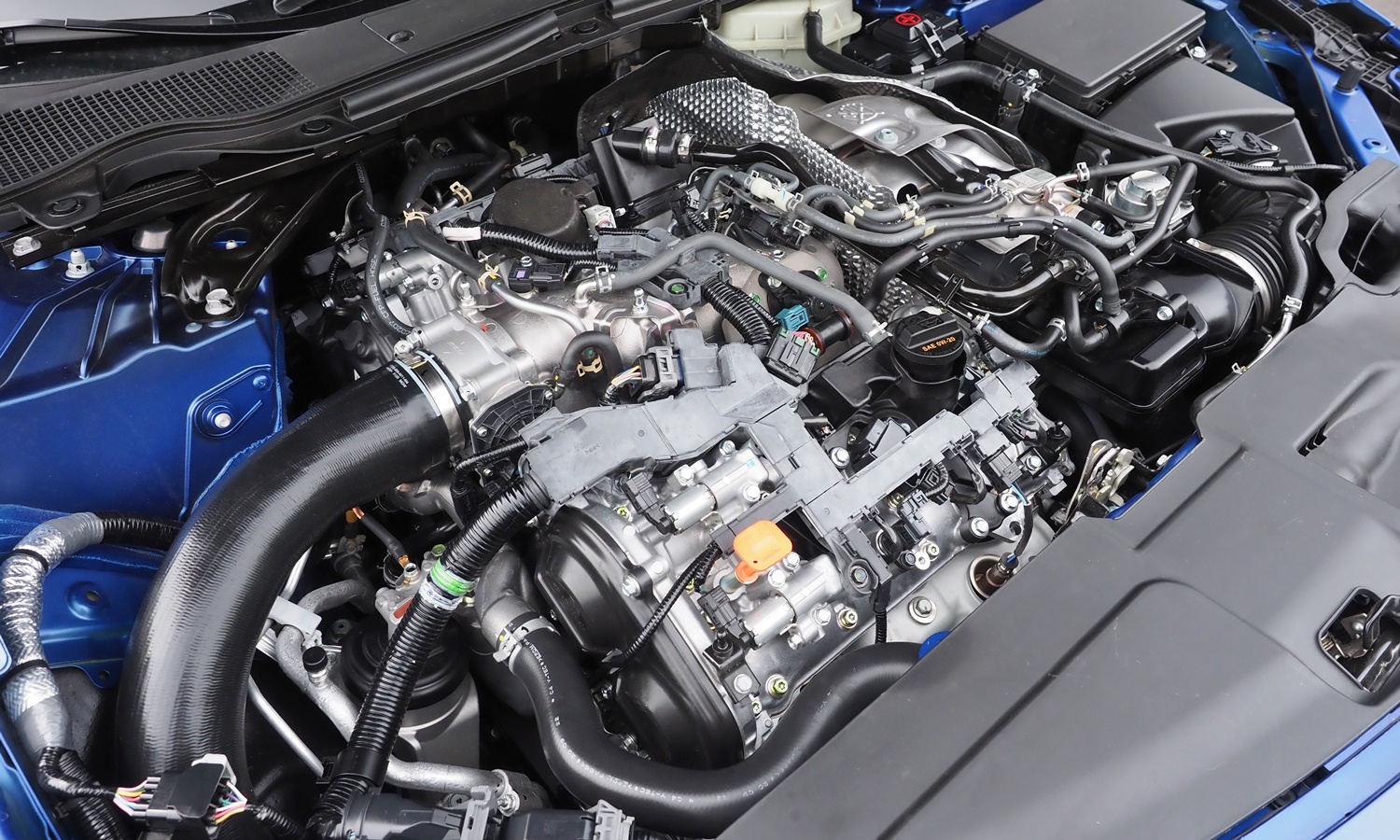
New turbo V6 in Type S much stronger and more responsive, and makes better noises (adjustable).
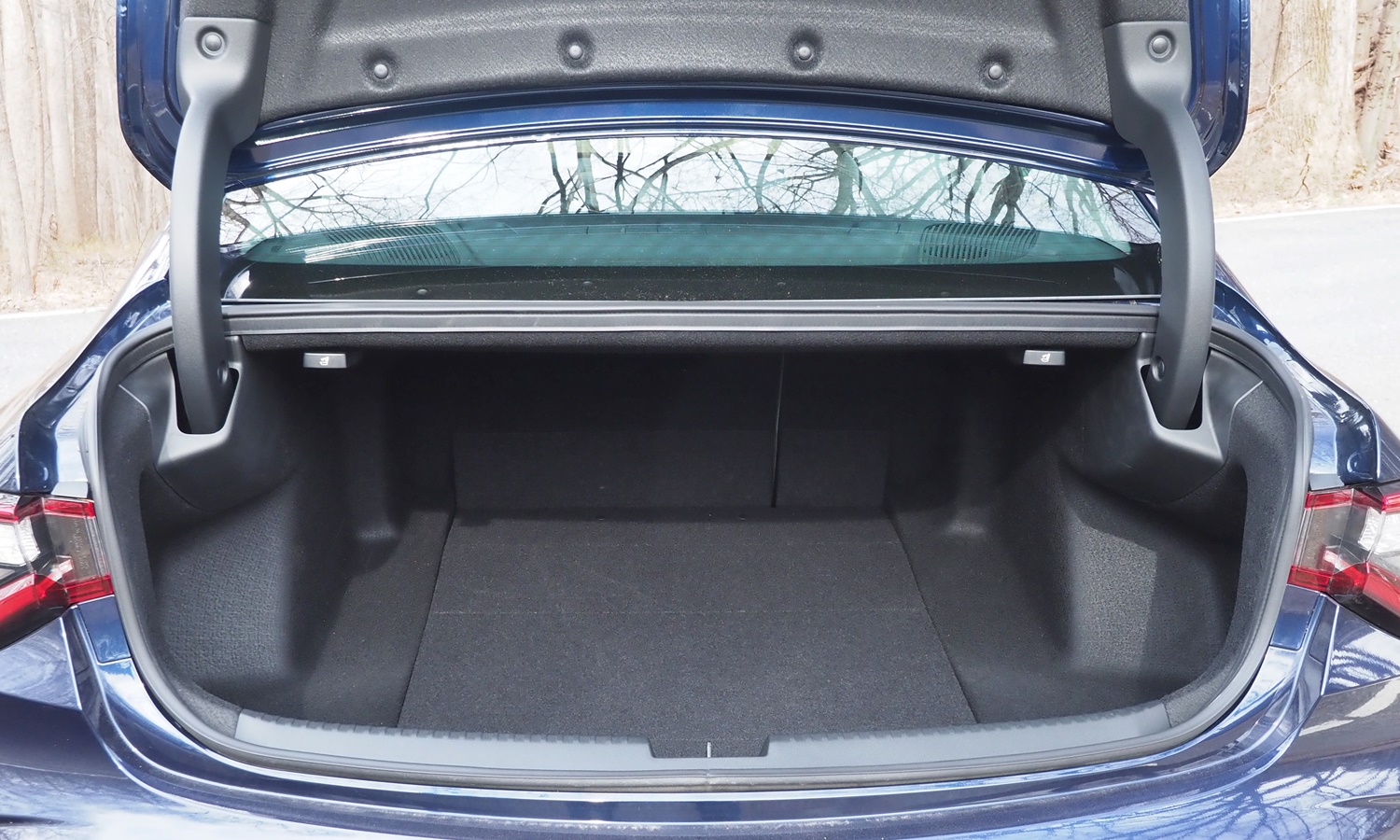
Decent-sized trunk--in part because there's no spare.
See more 2021 Acura TLX photos
Acura provided an insured car for a week with a tank of gas. Acura and Genesis also provided cars at regional media association events.











